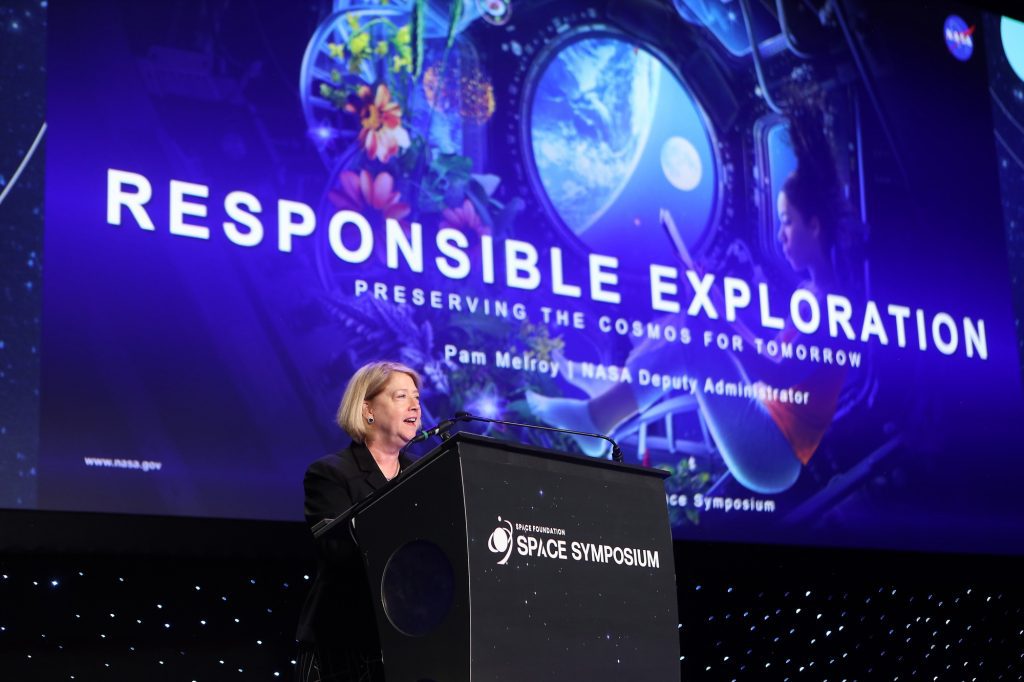COLORADO SPRINGS — NASA has declared a new method of handling the increasingly crowded and hazardous space around Earth by using a strategy focused on understanding the problem first rather than immediately pursuing solutions.
NASA released the initial segment of a combined Space Sustainability Strategy outlining six objectives for NASA, collaborating with the rest of the space community, to gain a better insight into the growing risks posed by debris in Earth's orbit and ways to minimize those risks.
In a speech at the 39th Space Symposium, NASA Deputy Administrator Pam Melroy explained that the strategy aims to address the complexity of the topic. She highlighted her uncertainty about the most impactful actions and criticized past analyses for being too simplistic. She expressed the need to move beyond common sense and intuition.th Therefore, the initial goal of the new strategy is to improve the understanding of the complexity of the issue, as Melroy stated. She emphasized the importance of establishing a widely accepted framework for evaluating space sustainability and collaborating with both domestic and international stakeholders to establish a shared perspective.
“The framework plays a fundamental role in the success of the strategy,” remarked Charity Weeden, associate administrator for NASA’s Office of Technology, Policy, and Strategy, during a briefing. It will encompass the economic and technological aspects of sustainability.
“It’s going to seem intricate because it's a complex problem,” she added.
Melroy highlighted in her speech that the framework will enable NASA and others to gain a better understanding of the effects of simultaneous actions and determine the most critical uncertainties. The second goal of the strategy is to pinpoint the most crucial uncertain factors affecting space safety.
“We aim to achieve significant advancements in detecting and predicting the space environment, exploring new operational approaches, and identifying cost-effective methods to minimize debris creation,” she stated, in addition to managing risks from existing debris.
Melroy emphasized that only after this would NASA be prepared to invest in space sustainability technologies. She indicated that this comes third, despite being the part everyone typically prioritizes.
As part of the third goal, she stated that NASA will develop a technology portfolio to tackle the issues identified in the framework and address the critical uncertainties. These technologies will encompass orbital debris management, improved space situational awareness, traffic coordination, and environmental understanding.
Additionally, NASA will devise transition plans to transfer these technologies to other users as a crucial aspect of the goal to benefit the entire space community, not just NASA.
Two other goals focus on policy and coordination, with NASA working to update its internal policies for debris mitigation and support for active debris removal. Melroy emphasized the need to loosen the constraints on NASA's support for active debris removal technologies.
The rule also instructs NASA to work with other government agencies, as well as with commercial and international users of space. For example, NASA is working with the Office of Space Commerce on its Traffic Coordination System for Space, or TraCSS, civil space traffic coordination system.
“We are proud to collaborate with the Office of Space Commerce,” Melroy said at the briefing, noting cooperation on the research and development aspects of TraCSS. “What I would hope is that if we come out with this strategy, it would feed their technology investments as well.”
The sixth and final goal is for NASA’s internal organization on the issue. The agency plans to hire a director of space sustainability in the coming months to lead implementation of the strategy.
Melroy said at the briefing that it was too early to discuss funding for the strategy, especially investments in technologies, with the agency focusing in the near term on framework goal. “Let’s figure out what we’re doing first and what impact it will have,” she said.
She added that with internal NASA planning already underway for its fiscal year 2026 budget proposal, to be released early next year, funding for space sustainability technology development projects that emerge from the strategy may have to wait until the fiscal year 2027 proposal.
Melroy stressed in her presentation that NASA’s work in space sustainability will be focused on science and technology, with no interest in taking on any kind of regulatory or operational role.
“There are people who would like to see us be the space Coast Guard,” she said. “As a science and technology organization, we should be developing those capabilities and then transitioning them to users.”
Yet, while she emphasized NASA is taking a deliberate approach, Melroy underlined the urgency of the problem. In her speech, she discussed the close approach between NASA’s TIMED spacecraft and a defunct Russian satellite, Cosmos 2221, Feb. 28. Neither satellite could maneuver to avoid a collision, and Melroy said later analysis showed the two spacecraft passed less than 10 meters from each other, narrowly avoiding a catastrophic collision.
“It was very shocking personally and for all of us at NASA,” she said. “The TIMED spacecraft really scared us all.”
NASA announced a new approach to dealing with an increasingly crowded and dangerous environment in Earth orbit with a space sustainability strategy that puts an initial emphasis on analyzing the problem rather than technologies to solve it.









